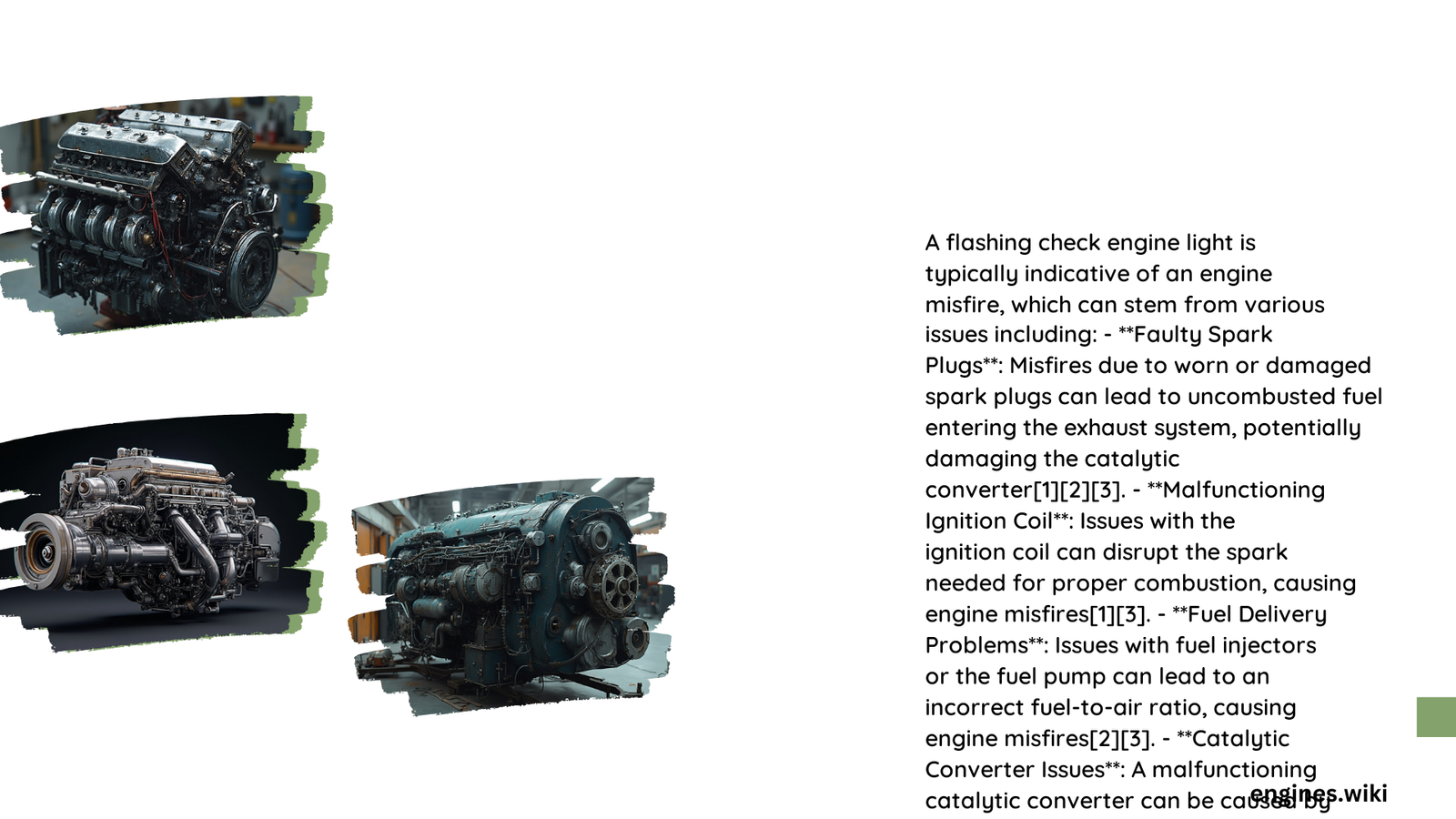A flashing check engine light is a serious warning that requires immediate attention. Common causes include engine misfires, faulty catalytic converters, and oxygen sensor failures. These issues can lead to severe engine damage, reduced fuel efficiency, and increased emissions. Understanding the causes and taking prompt action can prevent costly repairs and ensure your vehicle’s longevity and performance.
What Are the Main Causes of a Flashing Check Engine Light?
The primary causes of a flashing check engine light include:
- Engine misfires
- Faulty catalytic converters
- Oxygen sensor failures
- Severe ignition system problems
- Fuel system malfunctions
Let’s explore each of these causes in detail.
Why Does an Engine Misfire Trigger a Flashing Check Engine Light?

An engine misfire is one of the most common and serious causes of a flashing check engine light. When an engine misfires, it means that one or more cylinders are not firing properly, leading to a range of issues:
- Symptoms:
- Shaking or vibrations
- Jerky acceleration
- Loss of power
- Strange engine sounds
-
Smell of unburned fuel
-
Diagnostic Trouble Codes (DTCs):
-
P0300-P0308 (indicating misfires in specific cylinders or random misfires)
-
Causes of Misfires:
- Faulty spark plugs
- Damaged ignition coils
- Clogged fuel injectors
- Vacuum leaks
- Low fuel pressure
Engine misfires can cause uncombusted fuel to be dumped into the exhaust system, potentially damaging the catalytic converter and leading to more severe issues if not addressed promptly.
How Does a Faulty Catalytic Converter Cause a Flashing Check Engine Light?
A faulty catalytic converter can trigger a flashing check engine light, especially when it’s overheating due to uncombusted fuel from engine misfires. Here’s what you need to know:
| Aspect | Details |
|---|---|
| Temperature Threshold | Can exceed 1,200°F in severe cases |
| Consequences | Potential converter failure or fire |
| Impact on Emissions | Significant increase in HC, CO, and NOx emissions |
When a catalytic converter fails, it can no longer effectively reduce harmful emissions, leading to:
- Increased exhaust emissions
- Reduced engine performance
- Poor fuel economy
- Potential engine damage if left unaddressed
What Role Does an Oxygen Sensor Failure Play in Triggering a Flashing Check Engine Light?
Oxygen sensor failures can cause a flashing check engine light by disrupting the engine’s air-fuel mixture management. Here’s how it affects your vehicle:
- Normal Operating Range: 0.1V to 0.9V for narrowband sensors
- Impact on Fuel Efficiency: Can reduce fuel efficiency by 10-20% or more
- Consequences of Failure:
- Inaccurate air-fuel mixture readings
- Engine running too rich or too lean
- Increased emissions
- Reduced engine performance
A faulty oxygen sensor can lead to poor air-fuel mixture adjustments, resulting in decreased MPG and potentially causing engine misfires or other serious issues.
How Do These Issues Interrelate and Create Cascading Effects?
The interrelationship between engine misfires, faulty catalytic converters, and oxygen sensor failures can create a domino effect of problems:
- Engine Misfires:
- Lead to increased wear on engine components
- Cause damage to the catalytic converter
-
Result in poor fuel economy
-
Faulty Catalytic Converters:
- Can cause further misfires
- Damage other emissions system parts
-
Lead to failed emissions tests
-
Oxygen Sensor Failures:
- Disrupt the air-fuel mixture
- Cause poor engine performance
- Increase emissions
This interconnected nature of these issues underscores the importance of addressing a flashing check engine light promptly to prevent more extensive and costly damage.
What Are the Repair Costs Associated with These Issues?
Repair costs can vary significantly depending on the specific issue and your vehicle model:
| Issue | Estimated Cost Range |
|---|---|
| Oxygen Sensor Replacement | $200 – $500 |
| Catalytic Converter Replacement | $500 – $2,000+ |
| Spark Plug Replacement | $50 – $200 |
| Ignition Coil Replacement | $150 – $400 |
These costs can escalate if multiple components need replacement or if the issues have caused additional damage to the engine or exhaust system.
How Can Regular Maintenance Help Prevent These Issues?
Regular maintenance is key to preventing many of the issues that cause a flashing check engine light. Here are some recommended maintenance intervals:
- Spark Plugs: Replace every 30,000 to 100,000 miles
- Oxygen Sensors: Replace every 50,000 to 100,000 miles
- Air Filters: Replace every 15,000 to 30,000 miles
- Fuel Filters: Replace every 20,000 to 40,000 miles
Always consult your vehicle’s owner’s manual for specific maintenance schedules, as they can vary by make and model.
By adhering to these maintenance schedules and promptly addressing any warning signs, you can significantly reduce the risk of experiencing a flashing check engine light and the associated costly repairs.
Remember, a flashing check engine light is a serious warning that requires immediate attention. If you encounter this issue, it’s best to pull over safely and have your vehicle towed to a reputable mechanic for diagnosis and repair.
